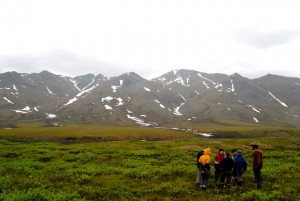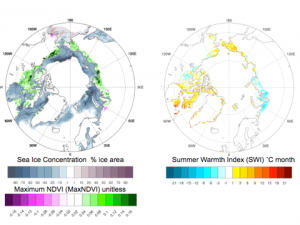Sea ice decline spurs the greening of the Arctic
August 21, 2013

907-474-5229
8/21/13
Sea ice decline and warming trends are changing the vegetation in nearby arctic coastal areas, according to two University of Alaska Fairbanks scientists.
Uma Bhatt, an associate professor with UAF’s Geophysical Institute, and Skip Walker, a professor at UAF’s Institute of Arctic Biology, contributed to a recent review of research on the response of plants, marine life and animals to declining sea ice in the Arctic.
“Our thought was to see if sea ice decline contributed to greening of the tundra along the coastal areas,” Bhatt said. “It’s a relatively new idea.”
The review appeared in a recent issue of Science magazine. It is a close, comprehensive look at how the losses of northern sea ice affect surrounding areas. Bhatt and Walker were two of ten authors.
The review team analyzed 10 years worth of data and research on the subject. The findings show that sea ice loss is changing marine and terrestrial food chains. Sea-ice disappearance means a loss of sea-ice algae, the underpinning of the marine food web. Larger plankton is thriving, replacing smaller, but more nutrient dense plankton. What that means exactly is not yet understood.
Above water, loss of sea ice has destroyed old pathways of animal migration across sea ice while opening new pathways for marine animals in others. Some animals and plants will become more isolated. In the case of the farthest north and coldest parts of the Arctic, entire biomes may be lost without the cooling effects of disappearing summer sea ice.
Walker, a plant biologist, says warming soils provide an opportunity for new vegetation to grow where less vegetation occurred previously. This contributes to a general greening of the Arctic that is visible from space. Bhatt, an atmospheric scientist, examined a 1982-2010 time series of remote sensing data to examine trends in sea ice, land-surface temperatures and changes in the vegetation abundance.

A surprising and puzzling finding shows that despite a general warming and greening of Arctic lands in North America, some areas in northern Russia and along the Bering Sea coast of Alaska are showing recent cooling trends and declines in vegetation productivity.
“We don’t know why,” Bhatt said.
This all illustrates the complexity of the arctic system and why scientists from different disciplines should work together to understand it, Bhatt said. The review article is one of the first steps in this direction.
“It’s not a simple story here,” Bhatt said. “I’m an atmospheric scientist and Skip (Walker) is a plant biologist. We have had many conversations to understand each other so we might better understand what’s happening in the Arctic.”
ADDITIONAL CONTACTS: Uma Bhatt, 907-474-2662, bhatt@gi.alaska.edu, Skip Walker, 907-474-2460, dawalker@alaska.edu and Amy Hartley, 907-474-5823, amy.hartley@gi.alaska.edu
ON THE WEB: http://www.sciencemag.org/content/341/6145/519.short
DC/8-21-13/039-14


